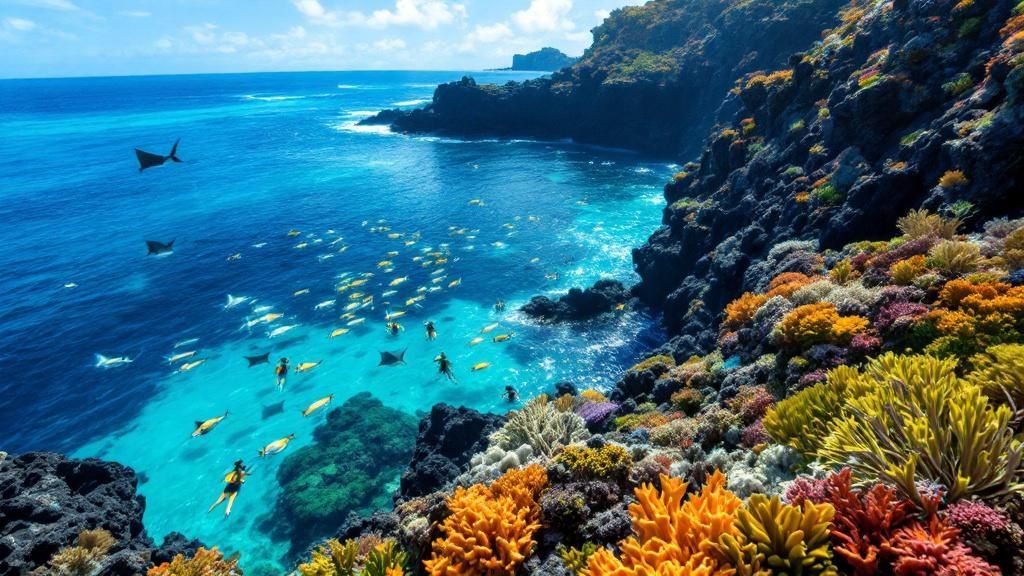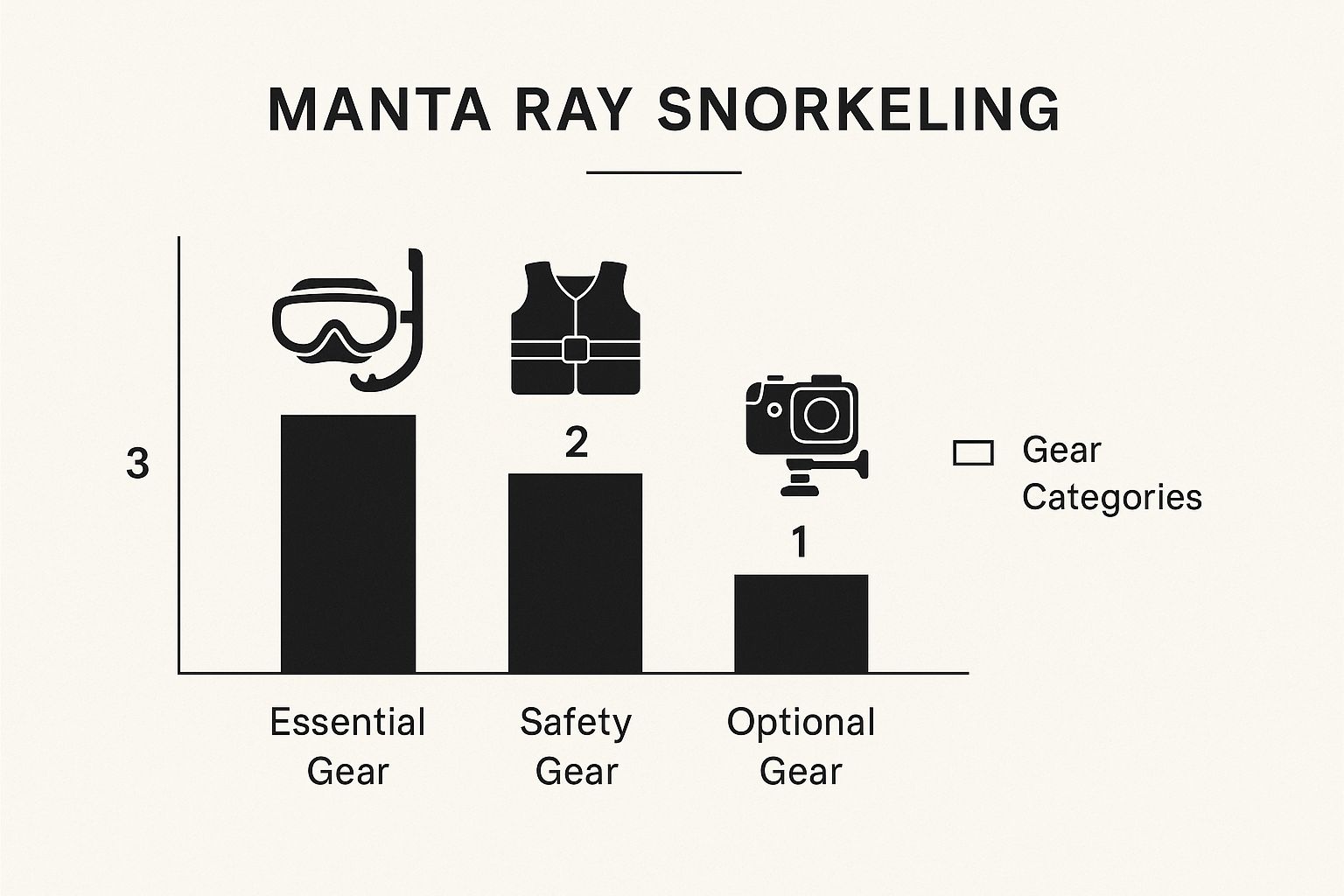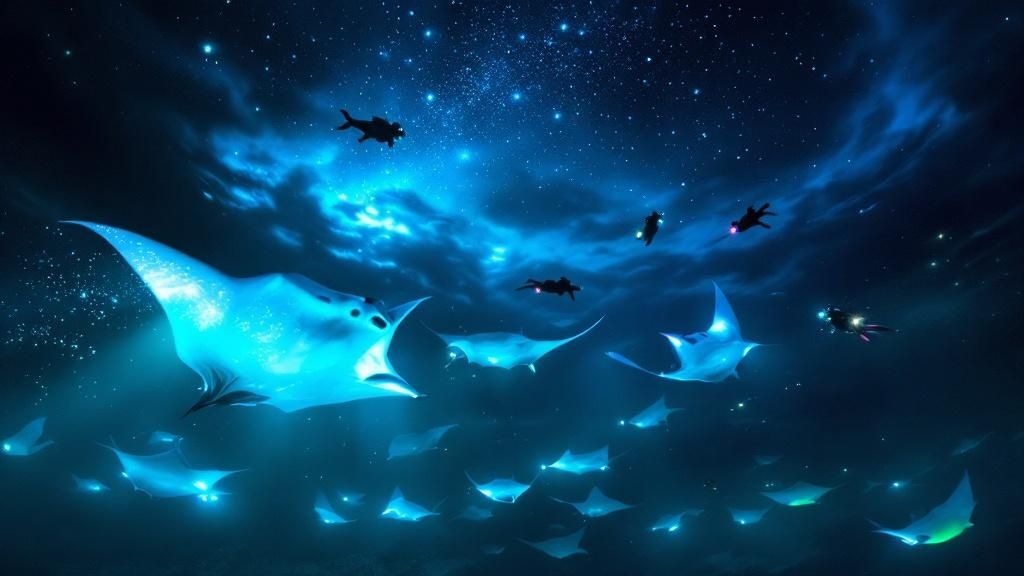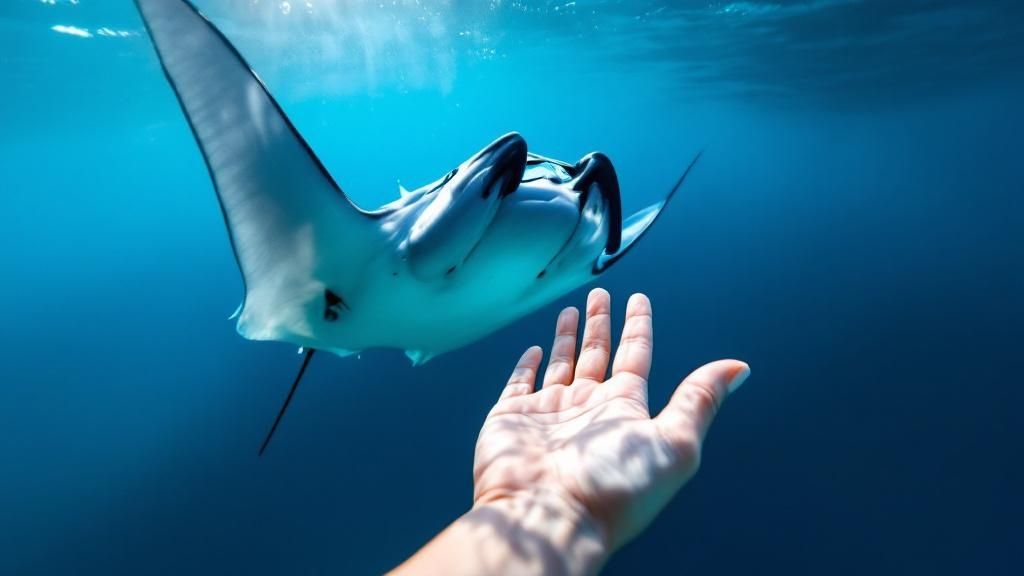Manta Ray Snorkel Big Island: Experience Nighttime Marine Adventure
- Byron
- Jul 12
- 11 min read
Picture this: you’re floating in the warm, dark Pacific waters off the Kona coast. Suddenly, a giant, graceful manta ray glides effortlessly just inches beneath you, its mouth wide open, filtering plankton in the beams of underwater light. This isn't a scene from a nature documentary—it's the very real, awe-inspiring experience of a manta ray snorkel on the Big Island.
This guide is your all-access pass to making this bucket-list adventure a reality.
Your Unforgettable Night Snorkel with Manta Rays
We'll dive into what makes Kona the world's absolute best spot for manta encounters and show you exactly how to choose the perfect tour for a safe, ethical, and truly unforgettable experience. But don't just take my word for it—see what fellow adventurers who have joined us at Manta Ray Night Snorkel Hawaii have to say.
Ready to see the magic for yourself?
Why the Big Island is a Global Hotspot
The Kona Coast isn't just a good place to see mantas; it's hands-down the best place in the world. What’s the secret? It comes down to our unique volcanic underwater landscape and nutrient-rich waters. This combination creates a reliable, year-round buffet for the mantas, attracting a large, residential population that sticks close to shore.
This consistent food source has made the manta ray night snorkel a cornerstone of Big Island tourism, with nearly 80,000 people joining the fun every single year.
The conditions are so reliable that tour operators boast an 85-90% sighting success rate all year long. In fact, detailed logs from famous sites like Manta Village and Manta Heaven showed that between 2009 and 2014, mantas were spotted six to seven nights a week. This incredible consistency is what allows visitors to witness the world-famous "manta ray ballet," where these gentle giants perform breathtaking feeding loops. You can get more great insights on Kona's manta ray tourism over at konahonudivers.com.
This unique spectacle, combined with Kona's stunning volcanic backdrop, cements the Big Island as a world-class destination for manta ray snorkeling.
This is so much more than just a tour; it's a chance to connect with one of the ocean's most majestic creatures in their natural feeding grounds. To learn even more, check out our guide on why the manta ray snorkel is a must-do underwater adventure.
Why the Kona Coast Is the Manta Ray Capital of the World
Ever wonder what makes the manta ray snorkel Big Island experience so famous? It isn't just a happy accident. It’s a perfect mix of the island's unique geology and biology that has turned the Kona coast into the world's undisputed hotspot for manta rays. Think of it as a five-star, all-you-can-eat buffet that these gentle giants just can't pass up.

The island’s volcanic past carved out sheltered bays and gentle underwater slopes. These features naturally trap and concentrate plankton—the manta rays' favorite meal—right near the shore. For the mantas, this is the most reliable restaurant in town, and they show up for dinner almost every single night.
Consistent and Predictable Encounters
This natural setup has created what we call "aggregation sites," which are basically permanent dinner spots for the mantas. The two most famous sites are Manta Village, near Keauhou Bay, and Manta Heaven, closer to the airport.
Because the mantas are so reliable, tour operators can simply set up their light boards—which act like floating "campfires" to attract plankton—and wait for the show to begin. It's this predictability that makes the manta ray snorkel on the Big Island a world-famous adventure with such an incredibly high success rate.
It's one thing to spot a manta ray by chance in the wild. It’s a whole different feeling to float above a known gathering spot where encounters are practically guaranteed, letting you have a truly immersive and breathtaking experience.
The best part? This population isn't just passing through; they live here year-round. Kona is home to a stable manta ray population of over 450 identified individuals, making it a vital and protected gathering spot. These encounters happen in water that’s just 30 to 40 feet deep, so it’s perfectly accessible for snorkelers of all skill levels. You’ll get 45 to 60 minutes in the water, giving you plenty of time to watch these majestic animals, some with wingspans over 12 feet, perform their graceful feeding ballet. You can read more about what makes Kona's manta dives so special at konahonudivers.com.
A Personal Connection with Marine Life
What really takes this from a cool tourist activity to something truly special is the personal connection researchers and guides have with the local rays. For decades, they have been identifying individual mantas by the unique spot patterns on their bellies, even giving them names.
So, you aren't just seeing a manta ray. You might be meeting "Lefty," "Big Bertha," or "Kailey," each a well-known personality in Kona's underwater community. This personal touch turns your snorkel into a meaningful interaction with a protected and beloved marine population. You are truly a guest in their home, witnessing the nightly ritual that has made Kona famous. Learn more about our incredible tours on our homepage.
How to Choose the Best Manta Ray Snorkel Tour
With so many companies offering a manta ray snorkel Big Island experience, picking the right one can feel a bit overwhelming. But when you know what to look for, booking the perfect adventure is actually pretty simple. Your choice will shape everything from the boat ride out to the quality of your face-to-face time with the mantas.
First, you'll need to decide on the location. Most tours head to one of two main sites: Manta Village near Keauhou Bay or Manta Heaven near the airport. Each has its own vibe.
We've put together a quick comparison to help you see the differences at a glance.
Kona Manta Ray Snorkel Locations Compared
Feature | Manta Village (Keauhou Bay) | Manta Heaven (Garden Eel Cove) |
|---|---|---|
Location | South of Kona, near resorts | North of Kona, near the airport |
Boat Ride | Shorter (around 5-10 minutes) | Longer (around 30-45 minutes) |
Seasickness | Better for those prone to seasickness | Longer travel time can be a factor |
Crowds | Can be busy, but often has consistent sightings | Can also be busy; sightings are excellent |
Best For | Families, those short on time, or anyone who gets seasick | Adventurous snorkelers who don't mind a longer boat trip |
Ultimately, both locations offer incredible, world-class manta encounters. The best choice really just depends on your personal preference for travel time and your group's needs.
Prioritizing Manta-Safe Operators
Here’s the single most important thing: choose a company that is Manta-Safe certified. This isn't just a fancy sticker for their boat; it's a genuine commitment. It means the tour operator adheres to strict guidelines designed to protect the rays and their delicate ocean home.
These rules are absolutely vital for the long-term health of Kona's resident manta ray population. A certified operator guarantees:
Passive Observation: You're there to watch the magic, not participate. This means no touching, no chasing, and no free-diving toward the mantas.
Proper Lighting: They use specially designed light boards that draw in plankton without harming or disorienting the rays.
Expert Guidance: The crew knows more than just safety drills; they're experts in manta biology and conservation, and they’re passionate about sharing that knowledge.
Booking a certified tour like ours at Manta Ray Night Snorkel Hawaii means your bucket-list adventure also helps protect these incredible animals.
What Separates a Good Tour from a Great One
Beyond the certification, the little details are what turn a good tour into an unforgettable one. Always look for companies that offer small group sizes. Fewer people mean a more personal, intimate experience and less bumping elbows at the light raft. You get a much better, totally unobstructed view of the underwater ballet.
The gear they provide makes a huge difference, too. A high-quality, well-fitting wetsuit keeps you warm and comfortable, letting you focus completely on the mantas instead of feeling a chill.

While the basics are a given, it's the professional-grade safety equipment that truly sets a top-tier operator apart. When you're making your final choice, weigh the boat's comfort, the crew's expertise, and the company's real commitment to conservation. For a more detailed breakdown, check out our ultimate guide to manta ray snorkeling tips.
What to Expect During Your Manta Ray Adventure
Alright, so you’ve booked your tour and the countdown is on. The excitement is probably starting to feel very real! To help you get the most out of every moment, let’s walk through what a typical manta ray snorkel Big Island adventure looks like from start to finish.
First things first, your journey begins on the boat. As you climb aboard, the expert guides from a top-notch crew like Manta Ray Night Snorkel Hawaii will give you a warm welcome. They'll run through a complete safety briefing, explaining the "rules of the road" for interacting with mantas, sharing some amazing facts about these gentle giants, and getting you fitted with your gear. That includes a snug wetsuit to keep you perfectly warm and buoyant in the water.

The Journey to the 'Campfire'
With everyone geared up and ready, you'll take off on a gorgeous boat ride. If you've booked a sunset tour, get ready for some truly spectacular views of the Kona coastline as the sun melts into the Pacific. It’s a show before the show!
Once you reach the snorkel spot—either Manta Village or Manta Heaven—the crew gets to work setting up a large, floating light raft.
Just think of this raft as an underwater "campfire." Its powerful lights beam down into the dark water, illuminating massive clouds of microscopic plankton. For the local manta rays, this is the dinner bell ringing loud and clear.
The moment you slip into the calm, dark ocean is just unforgettable. You'll swim over to the bright glow of the raft and grab onto one of its handles to find your spot. This raft isn't just for light; it's your stable, front-row seat to the whole spectacle.
You'll float comfortably right on the surface, holding onto the raft with your mask in the water, just waiting for the main event. Trust me, the anticipation in these moments is a huge part of the thrill.
The Famous Manta Ray Ballet
And then… it happens. A massive, dark shape emerges from the blackness, gliding effortlessly into the light. Soon, another follows, and then another. You’re now watching the legendary manta "ballet."
It’s a completely surreal experience. These gentle giants, some with wingspans stretching over 12 feet, perform mesmerizing barrel rolls just inches below your face. With their huge mouths wide open, they swoop and soar through the light beams, filtering the plankton-filled water for their dinner. For a brief, magical time, you're not just an observer; you are part of their world.
You can expect to be in the water for about 45-60 minutes, which is more than enough time to be totally captivated. The guides are always right there in the water with you, making sure everyone is safe, comfortable, and having an amazing time. If you’re curious about the science behind this incredible gathering, you can learn more about Hawaii's underwater magic and what makes this spot so unique.
After the encounter, you'll climb back onto the boat, buzzing with awe and adrenaline. It’s an experience that absolutely lives up to its world-class reputation.
Safe and Respectful Manta Ray Interaction
When you join a manta ray snorkel Big Island tour, you’re stepping into their world. Think of it less like a tourist attraction and more like being a guest in their underwater dining room. The whole point is to watch the magic unfold without getting in the way. Following a few simple guidelines is key for keeping both you and these amazing animals safe.

The biggest reason for this hands-off approach? Manta rays have a thin, protective mucus layer covering their bodies. It's basically their immune system, but on the outside. If you touch a manta, even by accident, you can rub this coating off. This leaves them wide open to nasty bacteria and infections they would otherwise be protected from.
The Golden Rules of Manta Etiquette
To make sure this experience is safe and sustainable for years to come, everyone needs to follow a few simple but non-negotiable rules. The best operators, like us here at Manta Ray Night Snorkel Hawaii, live by these guidelines to protect Kona’s beloved manta population.
Observe Only, Do Not Touch: This is the big one. It can be tempting to reach out, but you have to resist. Let the mantas be in charge of the encounter. If one happens to brush up against you, it’s because they chose to—not the other way around.
Stay on the Surface: As a snorkeler, your job is to float. Don’t try to dive down toward the mantas. Doing so can mess with their feeding patterns and turn a peaceful ballet into a chaotic mess for everyone.
Hold the Light Raft: The light raft is your stable, front-row seat to the show. By holding on, you stay in the perfect viewing spot and keep a safe, predictable distance from the action.
Keep Your Legs Horizontal: Let your fins and legs float flat behind you, almost like you have a tail. This simple trick prevents you from accidentally kicking a ray as it glides gracefully just inches beneath you.
Following these rules isn’t just about safety checklists; it’s about becoming an active partner in conservation. The long-term health of this incredible encounter depends entirely on the combined efforts of tour operators and guests like you. For a closer look at how this delicate balance is managed, you can check out this complete guide to manta encounters.
By following these guidelines, you’re helping ensure this breathtaking experience is around for future generations to enjoy. It’s a team effort, and we’re glad to have you on board.
Still Have Questions About Snorkeling With Manta Rays?
It's completely normal to have a few questions buzzing around your head before jumping into an adventure like this. After all, the manta ray snorkel Big Island tour is a truly unique experience, and being prepared is the key to soaking up every incredible moment.
We've put together some answers to the most common questions we hear. Our goal is to make sure you feel totally confident and excited before you book your once-in-a-lifetime trip with Manta Ray Night Snorkel Hawaii.
Here are some quick answers to get you ready.
When Is the Best Time of Year to See Manta Rays?
This is the best part—there really is no "bad" time! The manta ray snorkel is a fantastic, year-round activity here in Kona.
Our local manta ray population doesn't migrate. They stick around our calm coastal waters all year because there’s always a steady supply of their favorite food, plankton. Whether you're planning a trip in the heat of summer or the middle of winter, your chances for an amazing encounter are consistently high. In fact, most tours have over a 90% success rate for sightings. We run tours almost every single night, so you can book with confidence no matter when your Hawaiian vacation is.
Do I Need to Be a Strong Swimmer?
You definitely don't need to be Michael Phelps, but you should be comfortable in the water. We provide absolutely everything you need to feel safe and buoyant.
First, you'll get a high-quality wetsuit, which does a great job of keeping you warm and helping you float. The best part? For the entire encounter, you’ll be holding onto a large, custom-built floatation raft that has bright lights shining down into the water. You just float and watch the show unfold beneath you. No real swimming is required once you're at the site, making it an accessible and safe adventure for almost everyone.
What Should I Bring on My Tour?
You can pack pretty light for this trip, as we provide all the main gear. We've got you covered with:
A comfortable, well-fitting wetsuit
A professional mask and snorkel
Fins
All you really need to bring is a towel and a set of warm, dry clothes to change into after the snorkel. Even on a warm Hawaiian evening, the boat ride back can feel a little chilly once you're out of the water. An underwater camera is also a fantastic idea, but please make sure the flash is turned off. Bright flashes can bother the mantas and disrupt their feeding.
For a deeper dive into what to expect, check out our ultimate guide for unforgettable manta encounters.
Is This Tour Safe for Children?
Yes, many manta ray tours are fantastic for families! However, most operators have a minimum age, which is often around 5 to 7 years old. The most important thing isn't just their age, but how comfortable your child is with the idea of being in the ocean at night.
While our tours are professionally supervised and very safe, the darkness and the incredible size of the mantas can sometimes be intimidating for younger kids.
Before booking, it's always a good idea to check the specific age policy with us and have a chat with your child. Making sure they are genuinely excited about the adventure is the real secret to a wonderful family memory.
Comments